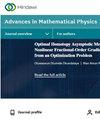拉伸/收缩板上充满三元混合纳米流体的希门茨流非独特解决方案的各个方面
IF 1.1
4区 物理与天体物理
Q3 PHYSICS, MATHEMATICAL
引用次数: 0
摘要
本研究旨在仔细研究三元混合纳米流体在拉伸/收缩片上的 Hiemenz 流动。本研究旨在考察拉伸/收缩参数和纳米粒子体积分数的变化对三元混合纳米流体流动的关键方面的影响,特别是表皮摩擦、努塞尔特数(与传热有关)、速度曲线和温度曲线。流动方程通过相似性变换转换成常微分方程(ODE)系统。随后,使用 MATLAB 软件的四阶精度边界值问题求解器(称为 "bvp4c")对该系统进行数值求解。数值计算结果表明,皮肤摩擦值随拉伸/收缩参数的大小而变化。此外,在所研究流动问题的特定背景下,混合(三元)纳米流体的热传导效率超过了混合纳米流体。该系统在特定的收缩/拉伸参数区间内产生了两种不同的解决方案。通过检查溶液的时间稳定性,可以确定只有一种溶液在较长时间内保持稳定。请记住,目前的这些发现仅适用于铜、氧化铝和二氧化钛的组合。本文章由计算机程序翻译,如有差异,请以英文原文为准。
Aspects of Non-unique Solutions for Hiemenz Flow Filled with Ternary Hybrid Nanofluid over a Stretching/Shrinking Sheet
This study is carried out to scrutinize the Hiemenz flow for ternary hybrid nanofluid flow across a stretching/shrinking sheet. This study aims to inspect the impacts of variations in the stretching/shrinking parameter and the volume fraction of nanoparticles on key aspects of the ternary hybrid nanofluid flow, specifically the skin friction, Nusselt number (which relates to heat transfer), velocity profiles, and the temperature profiles. The flow equations transform into a system of ordinary differential equations (ODEs) using a similarity transformation. Subsequently, the system is numerically solved using the MATLAB software’s 4th-order accuracy boundary value problem solver, known as “bvp4c”. Numeric findings reveal that skin friction values exhibit variations based on the magnitude of the stretching/shrinking parameter. Moreover, in the specific context of the flow problem being studied, the heat conduction efficiency of the hybrid (ternary) nanofluid surpasses that of the hybrid nanofluid. The system yields two distinct solutions within a specific shrinking/stretching parameter interval. Through an examination of the temporal stability of the solutions, it was determined that only one remained stable over an extended period. Remember that these current findings hold solely for the combination of copper, alumina, and titania.
求助全文
通过发布文献求助,成功后即可免费获取论文全文。
去求助
来源期刊

Advances in Mathematical Physics
数学-应用数学
CiteScore
2.40
自引率
8.30%
发文量
151
审稿时长
>12 weeks
期刊介绍:
Advances in Mathematical Physics publishes papers that seek to understand mathematical basis of physical phenomena, and solve problems in physics via mathematical approaches. The journal welcomes submissions from mathematical physicists, theoretical physicists, and mathematicians alike.
As well as original research, Advances in Mathematical Physics also publishes focused review articles that examine the state of the art, identify emerging trends, and suggest future directions for developing fields.
 求助内容:
求助内容: 应助结果提醒方式:
应助结果提醒方式:


